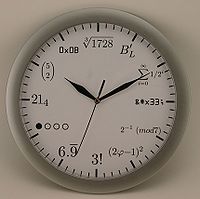Course:MATH103/Archive/2010-2011/207/Lectures/Lecture05
| Faculty of Science Department of Mathematics | |
|---|---|

| |
| Course Pages | |
| Course Policies | |
| Math Solvers | |
| Exams | |
| Quizzes | |
| Assignments | |
| Lectures | |
Lecture 5
Readings For This Lecture
- Chapter 3, pages 43 to 50 (up to subsection 3.6)
Summary
Group 12: Add a summary of the lecture in this space. Include examples, discussion, and links to external sources, if desired.
Exercises
1. Consider the integral . For what values of is this integral expression equal to zero?
| [show]Solution |
|---|
2. Consider the integral . For what values of is this integral expression equal to zero?
3. Discuss an application of integrals that makes explicit use of the 'negative area' property.
4. Consider the function on the interval . Find the area under this graph by using the Fundamental Theorem of Calculus.
5. Use an integral to approximate the sums .
6.Find the area between the two curves and y = x^{2}-1</math> for . Explain the relationship of your answer to the two integrals
and .
7. Find the area under the graph of from to . Extend the interval of integration to and compute the area. How about ? What happens as the left end point approaches 0? Can you explain?
8. Find the antiderivative of . Use this antiderivative to compute the integral . Confirm this formula by computing the area using sums of rectangular strips for the case .






![{\displaystyle [0,1]}](https://wiki.ubc.ca/api/rest_v1/media/math/render/svg/738f7d23bb2d9642bab520020873cccbef49768d)








![{\displaystyle [{\tfrac {1}{2}},3]}](https://wiki.ubc.ca/api/rest_v1/media/math/render/svg/4c7710ac3c17eb35a982dc4e7a8df7eb4b8d8504)
![{\displaystyle [{\tfrac {1}{4}},3]}](https://wiki.ubc.ca/api/rest_v1/media/math/render/svg/152ae1f1c53519ca1af502ba7db8d35a067161b7)


